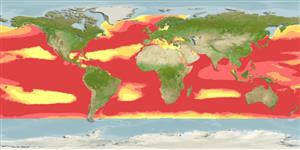Preferred temperature (Ref.
115969): 11.2 - 28.9, mean 23.9 (based on 7848 cells).
Phylogenetic diversity index (Ref.
82804): PD
50 = 0.8750 [Uniqueness, from 0.5 = low to 2.0 = high].
Bayesian length-weight: a=0.00102 (0.00046 - 0.00225), b=3.06 (2.88 - 3.24), in cm Total Length, based on all LWR estimates for this body shape (Ref.
93245).
营养阶层 (Ref.
69278): 3.2 ±0.40 se; based on food items.
回复力 (Ref.
120179): 非常低的, 最小族群倍增时间超过14 年 (Assuming tm>10; Fec = 139,000).
Fishing Vulnerability (Ref.
59153): Very high vulnerability (90 of 100).
Climate Vulnerability (Ref.
125649): Moderate vulnerability (37 of 100).
